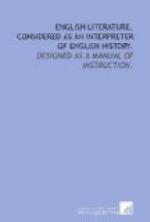GILDAS.—Among the writers who must be considered as belonging to the Celtic race, although they wrote in Latin, the most prominent is Gildas. He was the son of Caw, (Alcluyd, a British king,) who was also the father of the famous bard Aneurin. Many have supposed Gildas and Aneurin to be the same person, so vague are the accounts of both. If not, they were brothers. Gildas was a British bard, who, when converted to Christianity, became a Christian priest, and a missionary among his own people. He was born at Dumbarton in the middle of the sixth century, and was surnamed the Wise. His great work, the History of the Britons, is directly historical: his account extends from the first invasion of Britain down to his own time.
A true Celt, he is a violent enemy of the Roman conquerors first, and then of the Saxon invaders. He speaks of the latter as “the nefarious Saxons, of detestable name, hated alike by God and man; ... a band of devils breaking forth from the den of the barbarian lioness.”
The history of Gildas, although not of much statistical value, sounds a clear Celtic note against all invaders, and displays in many parts characteristic outlines of the British people.
ST. COLUMBANUS.—St. Colm, or Columbanus, who was born in 521, was the founder and abbot of a monastery in Iona, one of the Hebrides, which is also called Icolmkill—the Isle of Colm’s Cell. The Socrates of that retreat, he found his Plato in the person of a successor, St. Adamnan, whose “Vita Sancti Columbae” is an early work of curious historical importance. St. Adamnan became abbot in 679.
A backward glance at the sparse and fragmentary annals of the Celtic people, will satisfy us that they have but slight claims to an original share in English literature. Some were in the Celtic dialects, others in Latin. They have given themes, indeed, to later scholars, but have left little trace in form and language. The common Celtic words retained in English are exceedingly few, although their number has not been decided. They form, in some sense, a portion of the foundation on which the structure of our literature has been erected, without being in any manner a part of the building itself.
CHAPTER III.
ANGLO-SAXON LITERATURE AND HISTORY.
The Lineage of the Anglo-Saxon.
Earliest Saxon Poem. Metrical
Arrangement. Periphrasis and
Alliteration. Beowulf. Caedmon. Other
Saxon Fragments. The Appearance
of Bede.
THE LINEAGE OF THE ANGLO-SAXON.
The true origin of English literature is Saxon. Anglo-Saxon is the mother tongue of the English language, or, to state its genealogy more distinctly, and to show its family relations at a glance, take the following divisions and subdivisions of the




